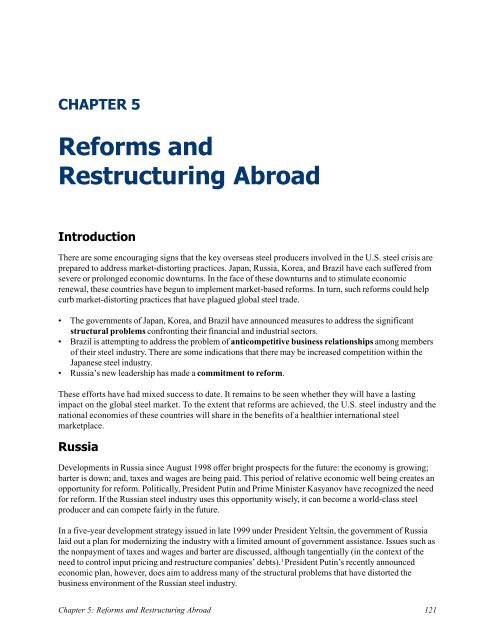Global Steel Trade; Structural Problems and Future Solutions
Global Steel Trade; Structural Problems and Future Solutions
Global Steel Trade; Structural Problems and Future Solutions
You also want an ePaper? Increase the reach of your titles
YUMPU automatically turns print PDFs into web optimized ePapers that Google loves.
CHAPTER 5<br />
Reforms <strong>and</strong><br />
Restructuring Abroad<br />
Introduction<br />
There are some encouraging signs that the key overseas steel producers involved in the U.S. steel crisis are<br />
prepared to address market-distorting practices. Japan, Russia, Korea, <strong>and</strong> Brazil have each suffered from<br />
severe or prolonged economic downturns. In the face of these downturns <strong>and</strong> to stimulate economic<br />
renewal, these countries have begun to implement market-based reforms. In turn, such reforms could help<br />
curb market-distorting practices that have plagued global steel trade.<br />
• The governments of Japan, Korea, <strong>and</strong> Brazil have announced measures to address the significant<br />
structural problems confronting their financial <strong>and</strong> industrial sectors.<br />
• Brazil is attempting to address the problem of anticompetitive business relationships among members<br />
of their steel industry. There are some indications that there may be increased competition within the<br />
Japanese steel industry.<br />
• Russia’s new leadership has made a commitment to reform.<br />
These efforts have had mixed success to date. It remains to be seen whether they will have a lasting<br />
impact on the global steel market. To the extent that reforms are achieved, the U.S. steel industry <strong>and</strong> the<br />
national economies of these countries will share in the benefits of a healthier international steel<br />
marketplace.<br />
Russia<br />
Developments in Russia since August 1998 offer bright prospects for the future: the economy is growing;<br />
barter is down; <strong>and</strong>, taxes <strong>and</strong> wages are being paid. This period of relative economic well being creates an<br />
opportunity for reform. Politically, President Putin <strong>and</strong> Prime Minister Kasyanov have recognized the need<br />
for reform. If the Russian steel industry uses this opportunity wisely, it can become a world-class steel<br />
producer <strong>and</strong> can compete fairly in the future.<br />
In a five-year development strategy issued in late 1999 under President Yeltsin, the government of Russia<br />
laid out a plan for modernizing the industry with a limited amount of government assistance. Issues such as<br />
the nonpayment of taxes <strong>and</strong> wages <strong>and</strong> barter are discussed, although tangentially (in the context of the<br />
need to control input pricing <strong>and</strong> restructure companies’ debts). 1 President Putin’s recently announced<br />
economic plan, however, does aim to address many of the structural problems that have distorted the<br />
business environment of the Russian steel industry.<br />
Chapter 5: Reforms <strong>and</strong> Restructuring Abroad 121
















